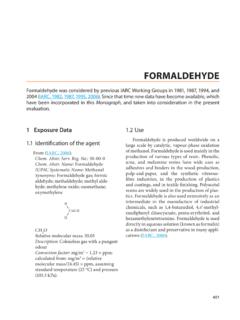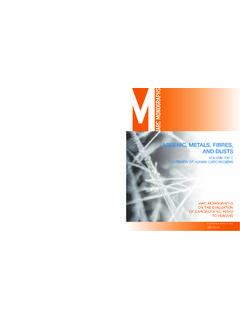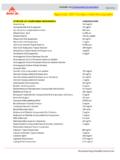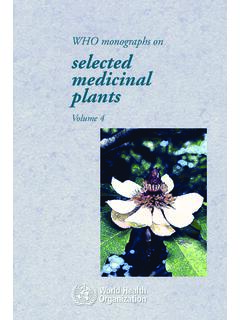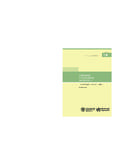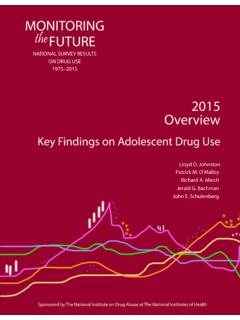Transcription of d-LIMONENE 1. Exposure Data - monographs.iarc.fr
1 d-LIMONENE . This substance was considered by a previous working group, in 1992 (IARC, 1993). Since that time, new data have become available, and these have been incorporated into the monograph and taken into consideration in the present evaluation. 1. Exposure Data Chemical and physical data Nomenclature Chem. Abstr. Serv. Reg. No.: 5989-27-5. Chem. Abstr. Name: (R)-1-Methyl-4-(1-methylethenyl)cyclohex ene IUPAC Systematic Name: (R)-(+)-para-Mentha-1,8-diene Synonyms: (+)-Dipentene; (R)-4-isopropenyl-1-methyl-1-cyclohexene ; d-LIMONENE ;. d-(+)-limonene; D-(+)-limonene; (+)-limonene; (+)- -limonene; (+)-(R)-limonene;. (+)-(4R)-limonene; (R)-limonene; (R)-(+)-limonene; (4R)-(+)-limonene; (+)-para- mentha-1,8-diene; (R)-p-mentha-1,8-diene; (R)-(+)-para-mentha-1,8-diene Structural and molecular formulae and relative molecular mass CH3.
2 H. C. H3C CH2. C10H16 Relative molecular mass: Chemical and physical properties of the pure substance (a) Description: Colourless liquid with characteristic citrus odour (National Toxicology Program, 1991). (b) Boiling-point: 176 C (Budavari, 1996). (c) Melting-point: C (National Toxicology Program, 1991); C has also been reported (Lide, 1991). (d) Density: g/cm3 at 20 C (National Toxicology Program, 1991). 307 . 308 IARC monographs VOLUME 73. (e) Solubility: Slightly soluble in water ( mg/mL at 25 C); soluble in acetone, dimethyl sulfoxide and ethanol (National Toxicology Program, 1991; National Library of Medicine, 1998). (f ) Volatility: Vapour pressure, 133 Pa at 14 C and 665 Pa at C; relative vapour density (air = 1), (National Toxicology Program, 1991).
3 (g) Conversion factor: mg/m3 = ppm Production and use Information available in 1995 indicated that d-LIMONENE was produced in Australia, Brazil, Germany, Japan and the United States (Chemical Information Services, 1995). d-LIMONENE has been used for many years as a flavour and fragrance additive in foods, beverages and consumer products. It is increasingly used as a solvent. It is also used in the manufacture of resins, as a wetting and dispersing agent and in insect control (National Toxicology Program, 1991; IARC, 1993; Budavari, 1996). d-LIMONENE and its metabolite perillyl alcohol are currently undergoing clinical trials for use in treatment of breast cancer and other tumours, and chemoprevention trials are under consideration (Gould, 1995; O'Shaugnessy, 1996; Vigushin et al.)
4 , 1998). Occurrence Natural occurrence d-LIMONENE is one of the most common terpenes in nature, occurring in citrus and a wide variety of other plant species. It is a major constituent of oil of citrus rind, dill oil, oil of cumin, neroli, bergamot and caraway (National Toxicology Program, 1991) [see IARC (1993) for a detailed discussion of its occurrence]. Occupational Exposure According to the 1981 83 National Occupational Exposure Survey (National Institute for Occupational Safety and Health, 1998), approximately 138 300 workers in the United States were potentially exposed to d-LIMONENE . Occupational Exposure to d-LIMONENE may occur during its production and use, notably as an industrial solvent. Environmental occurrence The average daily dietary intake of d-LIMONENE has been estimated to be about mg/kg bw (Flavor and Extract Manufacturers' Association, 1991).
5 d-LIMONENE has been detected in indoor and outdoor air in various locations (IARC, 1993; National Library of Medicine, 1998). Regulations and guidelines The 8-h time-weighted Exposure limit for d-LIMONENE in Sweden is 150 mg/m3 and the short-term (15 min) Exposure limit is 300 mg/m3 (National Board of Occupational Safety and Health, 1996). d-LIMONENE 309. No international guidelines for d-LIMONENE in drinking-water have been established (WHO, 1993). 2. Studies of Cancer in Humans No data were available to the Working Group. 3. Studies of Cancer in Experimental Animals Previous evaluation d-LIMONENE was tested for carcinogenicity by oral gavage in one study in mice and one study in rats. In mice and female rats, there were no treatment-related tumours, but male rats had renal tubular hyperplasia and a significantly increased combined incidence of renal tubular adenomas and carcinomas.
6 In a two-stage experiment, oral treatment with d-LIMONENE after administration of N-nitrosoethylhydroxyethylamine enhanced the development of renal tubular hyperplasia and renal tubular adenomas in male Fischer rats, which synthesize 2u -globulin in the liver in large quantities, but not in male NBR. rats, which do not (IARC, 1993). [The present Working Group reconfirmed the adequacy of the bioassays of d-LIMONENE in male and female mice and rats conducted by the National Toxicology Program as cited in IARC (1993), noting the convincing renal tumour response in male rats and the absence of renal tumours in female rats.]. New studies Administration with known carcinogens Mouse: In a model of lung carcinogenesis, groups of 25 female A/J mice, six to seven weeks of age, were fed d-LIMONENE in the diet at a concentration of for 17 weeks.
7 One week after commencement of treatment, the mice received an intraperitoneal injection of 10 mol 4-(methylnitrosamino)-1-(3 pyridyl)-1-butanone (NNK) in mL saline. d- Limonene treatment significantly reduced the number of lung tumours per mouse, from in mice given NNK alone to (p < ), although the percentage of mice with lung tumours was not significantly different between those given NNK (100%) and those given d-LIMONENE (96%) (El-Bayoumy et al., 1996). Rat: In a model of putative colonic preneoplasia, groups of 12 male Fischer 344 rats, five weeks of age, were given d-LIMONENE in the drinking-water (equivalent to in the diet) for five weeks. One week after the start of treatment, the rats received subcutaneous injections of 15 mg/kg bw azoxymethane once a week for three weeks and were killed at 10 weeks of age.
8 In rats given azoxymethane and d-LIMONENE , the frequencies of aberrant crypt foci and the numbers of aberrant crypts per focus and of aberrant crypts per colon were significantly decreased (p < to p < ) when compared with the group given azoxymethane alone (Kawamori et al., 1996). 310 IARC monographs VOLUME 73. In a multi-organ model of carcinogenesis, groups of 20 Fischer 344 male rats aged five weeks were treated sequentially with N-nitrosodiethylamine (100 mg/kg bw by intra- peritoneal injection as a single dose at the beginning of the study), N-methyl-N-nitrosourea (20 mg/kg bw by intraperitoneal injection four times during weeks 1 and 2), N-nitroso- butyl-N-(4-hydroxybutyl)amine ( in drinking-water during weeks 1 and 2), 1,2- dimethylhydrazine (40 mg/kg bw by subcutaneous injection four times during weeks 3 and 4) and N-nitrosodihydroxydipropylamine ( in drinking-water during weeks 3 and 4).
9 From the end of week 4, d-LIMONENE at doses of , 1 or 2% was administered in the diet for 24 weeks, when surviving rats were sacrificed ( 28 weeks after the start of the study). A group receiving 2% d-LIMONENE but no initiating carcinogen schedule was also included. The number of rats with renal tubular adenomas was statistically significantly increased (p < ) at the high dose of d-LIMONENE : 13/19 with the carcinogen schedule plus 2% d-LIMONENE and 4/19 with the carcinogen schedule alone. This increase in renal tumour incidence was accompanied by an increased number of atypical tubules (a preneo- plastic lesion) per rat. None of the rats fed 2% d-LIMONENE alone had a renal tumour. No modification of carcinogenesis was observed in any other organ (Kimura et al.)
10 , 1996). Hamster: In a model of pancreatic carcinogenesis, groups of 25 Syrian golden hamsters, five weeks of age, were given subcutaneous injections of 15 mg/kg bw N- nitrosobis(2-oxopropyl)amine in saline once a week for five weeks and simulta- neously fed chow pellets containing 0, 1 or 2% d-LIMONENE for up to 26 weeks, when the animals were killed. The high dose of d-LIMONENE significantly decreased the number of pancreatic carcinomas, from in the animals given the carcinogen alone to in the animals given carcinogen plus 2% d-LIMONENE (p < ) (Nakaizumi et al., 1997). 4. Other Data Relevant to an Evaluation of Carcinogenicity and its Mechanisms Absorption, distribution, metabolism and excretion Humans d-LIMONENE is absorbed from the gastrointestinal tract.

